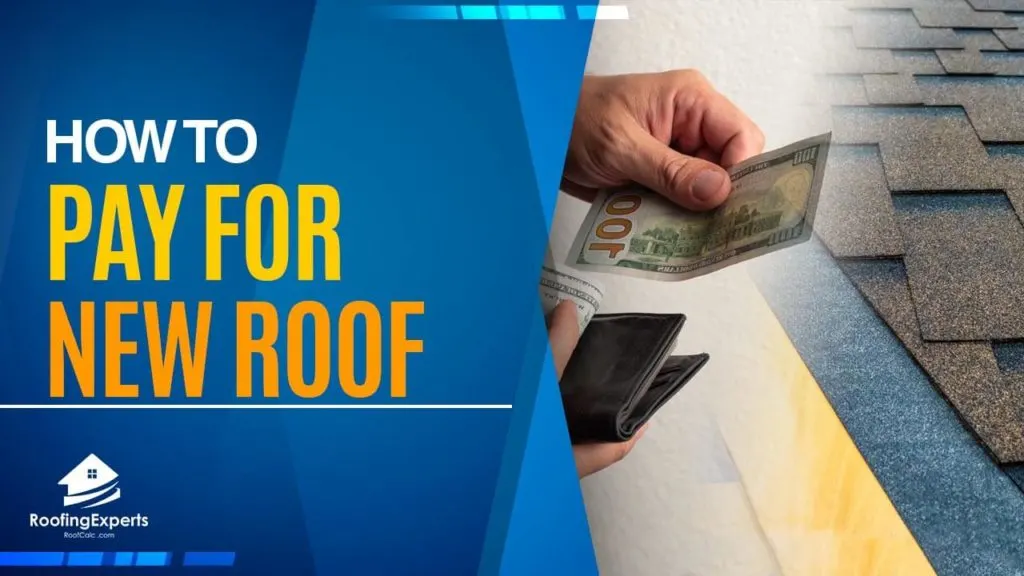
Many homeowners find themselves in a tough spot when they are faced with the prospect of paying for a new roof. The cost of labor and materials is high, so it can be difficult to scrounge up enough money to pay for it all at once.
Fortunately, there are some financing options available that will help you get your roof paid off over time with monthly payments that fit into your budget. This blog post will walk you through these options so you know how to pay for a new roof!
How To Pay For A New Roof
Different Financial Options
There are a few different types of financial options you can use to pay for your new roof.
- Paying for it with cash/check
The best way to pay for a new roof is to use cash or a check. This way, you know exactly how much money you are spending and there is no interest to be paid. You can also find deals this way, as many companies will give you a discount for paying in cash.
Paying in full is the most optimal method; however, this isn’t very common due to the large sum of money involved. If one is able to pay in full, they will save on interest charges and avoid having to make monthly payments. It also means that you won’t have to worry about your roofing contractor running off with your money.
One of the main disadvantages of paying in cash is that you may not have enough money saved up to cover the entire cost. In this case, you will need to consider borrowing money from a bank or using a credit card.
- Borrowing money from a bank/lender
If you don’t have the cash on hand, you can try a personal loan from a bank or credit union. This will allow you to borrow the money at a fixed interest rate and pay it back over time. Just make sure that the roofing company you choose is approved by the bank/lender so that the work is guaranteed.
Borrowing money from a bank is one of the most common methods for paying for a roof. This option has several advantages, such as:
- You can borrow a large sum of money, which will cover the entire cost of the roof.
- The interest rates are usually lower than credit card rates.
- You will only have to make one monthly payment that is due at the end of the loan’s term.
- There are several disadvantages that come into play when borrowing money from a bank. Some of these include:
- Many banks require homeowners to take out home insurance before they can grant them any funds for roofing. They will usually stipulate that you must use their preferred roofing contractor as well.
- The loan may take a few weeks or even months to process.
- You will need to have a good credit score in order to get a low interest rate.

- Using a credit card
If you don’t have enough money saved up to cover the entire cost of the roof, you can use a credit card to borrow the money. This option has several advantages, such as:
- You can borrow a large sum of money, which will cover the entire cost of the roof.
- The interest rates are usually lower than bank interest rates.
- You only need to make one monthly payment.
There are several disadvantages that come into play when using a credit card to borrow money for the roof. Some of these include:
- You will need to have an excellent credit score in order to get a low interest rate.
- There are fees associated with using a credit card that don’t usually come into play with other methods, such as paying cash or borrowing through a bank.
- The interest rates are usually higher than bank interest rates.
- You will need to pay for the roofing contractor yourself. The contractor cannot be paid through the credit card company nor can they hold your roof ransom until you pay them off.
Home equity loan
A loan invested in the equity of one’s home. Another option is to use a home equity line of credit (HELOC). This is a loan against the value of your home, which can be a very good option if you need a lot of money.
This allows you to borrow money against the equity in your home, and interest rate on a HELOC is usually lower than on other types of loans, and you can often get a long repayment period. However, it’s important to note that you are borrowing money against your home, so if you stop paying the loan, the lender can foreclose on your house.
Paying it with Insurance Claims
If you are renovating your roof, some providers will pay the cost of the replacement on your behalf. This is especially true if you have had a major storm that caused widespread destruction to homes in your area. However, this method comes with several caveats that must be considered beforehand.
- Firstly, it depends completely on whether or not your provider covers such an event and what the parameters surrounding it may be.
- Secondly, there could be potential insurance issues if one decides to take this route; meaning that one could end up losing their no-claims bonus and even be dropped from insurance altogether.
- Lastly, this option is only available for certain types of roofs such as flat roofs or shingle roofs (as opposed to tile or slate roofs).
- Roof company in-house financing
Some roof companies have their own finance company where they are the lender. This is an option available to customers who may not qualify with a bank or credit union for any reason. The roof company will check your credit score and income to see if you are approved for the loan.
The interest rate is usually a little higher than what you would get from a bank, but it does have the advantage of being flexible in terms of the length of the loan. You also have the option of using the roof company’s contractor or finding your own contractor.
- Government funded home improvement loans
A different kind of loan that is specific to home improvement projects – are also an option to consider. These loans come with low interest rates and terms that are typically longer than those offered by banks. They can be a great way to finance your roof replacement without breaking the bank.
There are a few things to consider before taking out a home improvement loan, however. One is that the interest rate on these loans can vary based on your credit score, so it’s important to check your score in advance and make sure you’re getting the best rate possible.
Additionally, home improvement loans typically require you to use the funds for a specific purpose – such as roof replacement – so make sure you are clear on those terms before signing up.
If you’re interested in learning more about government-funded home improvement loans, or want to apply for one, visit HUD’s website at hud.gov.
Tips on how to decide between these options:
- It is always best to discuss with your roofing contractor which options are available to you before making a final decision.
- Before deciding on a method, it is important to consider your current situation as well as the factors involved in each method of payment. For example, if you have a low credit score or are not comfortable with taking out a loan, then government-funded home improvement loans may be the best option for you. Or, if your roofing contractor offers in-house financing, that could be another good choice.
- Whatever route you choose, make sure to read the fine print and understand the terms and conditions before signing anything. This will help ensure that you are making the best decision for your needs and budget.
When considering the pros and cons of these three different methods, homeowners should keep certain factors in mind:
- How much money do you have saved up?
- How much do you think the roof is going to cost you and how long is it going to take to complete?
- What monthly payment can you afford?
- What monthly payment would be ideal for your budget?
- Do they offer home insurance with their preferred contractor or any other offers like shingles, nails etc.?
- What is the interest rate like?
- What are the fees associated with this method of payment?
- Do you have a good or excellent credit score?
- How quickly do they need to be paid off?
- Does your roofer offer discounts for paying cash directly through them rather than through another company (bank, credit card)?
So, now you know a few of the different ways to finance a new roof. It’s important to weigh all of your options carefully before deciding on which one is right for you. Talk to your roofing contractor, family and friends, and do some research to find the best option for your unique situation.
Conclusion
There are a variety of ways to finance a new roof, and it’s important to weigh all your options carefully before deciding on which one is right for you. Talk to your roofing contractor, family and friends, and do some research to find the best option for your unique situation.
Some of the most common methods include taking out a loan, using the roof company’s contractor, or using a government-funded home improvement loan.


